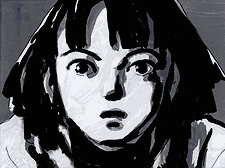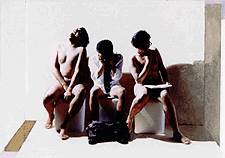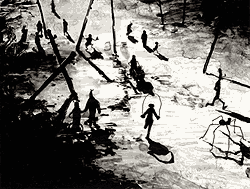Representing a new breed of Japanese animator, Keita Kurosaka and Koji Yamamura, have not chosen the beaten anime path, but rather an independent life. Gigi T. Y. Hu introduces us. Includes a Quicktime movie clip!
View a Quicktime movie clip of Koji Yamamura's 1999 film, Your Choice! Asserting Independence Despite the large-scale commercialization of Japanese animation beginning in the '60s, which led to the birth of a new genre, anime, there were animators who remained independent, working from their home-studios and small offices. Others formed small groupings of enterprising studios, serving the needs and interests of the non-commercial sector. Most of these independent animators were specialized artists often from the non-cel animation fields and preferring to animate with clay, puppets and so on.

Historically, the urge to assert independence began to take shape in the '70s with the formation of JAFA (Japan Animation Film Association) in 1971. JAFA's aim was "to promote animation culture in Japan." This period also saw the creation of two independent 16mm films, History of Japanese Animation Part I and II (Dir. Taiji Yabushita, 1970, 1972) charting the rise of Japanese animation from the early 20th century. JAFA was later renamed JAA (Japan Animation Association) in 1978 and has since thrived to hold annual or bi-annual film festivals providing space for independent animators to exhibit their work. The association currently has 130 members with job descriptions ranging from animators to film researchers, producers, screenwriters and educators. As JAA is a non-profit organization, most of its members volunteer their services to raise funds for the organization's events. The '70s also saw the formation of an avant-garde group under the prestigious premises of the Tokyo Image Forum. Linked to this group were also student and amateur animators looking for a platform to produce and screen their individual works. Then the inauguration of the Hiroshima International Animation Festival in 1985 created a trend, encouraging members of JAA and the Image Forum to produce high quality independent works for participation and competition.

Japan's New Breed
My first encounter with independent animators Keita Kurosaka and Koji Yamamura was at a fringe cinema, Box Higashi Nakano in the western part of Tokyo. The cinema is known for its non-mainstream, "underground" film selections catering to special interest audiences. At this particular exhibition, MTV Japan's (now known as vibE) animated shorts were shown which included works created by Kurosaka and Yamamura.
They are current JAA members and both were active once at the Tokyo Image Forum. Yet each treads an independent path in the tightly-knitted media industry of Japan. Working from home, Kurosaka excels in producing avant-garde art animation and teaches part-time at Musashino Art University. Yamamura excels in producing children's animation and owns a neatly set up studio which frequently provides part-time jobs to young freelance animators. Both are married with two children and occasionally baby-sit when requested! Both are also currently working on feature-length animations and looking for investors and overseas distributors.
During their interview sessions, both artists on separate occasions candidly volunteered information about their personal "industry rival," and each acknowledges the close competition. In short, they represent the new breed of Japanese animator who dares to take the less trodden path in the heavy corporate world of Japan. Each does not deny his wife's strong support of his career, and both women often double up as assistant animator and adviser when projects advance.
Unlike the immediate post-war baby-boomer generation which has been predominantly absorbed into large studio production houses beginning in the late '50s, Kurosaka and Yamamura were able to make choices, a luxury which their predecessors could hardly afford. Both entered the animation industry not through the manga path, but through their various independent productions. Thus, their story-telling and artistic worlds are fresh and original, offering new perspectives and visions. Keita Kurosaka: The Power to Explode Kurosaka, 43, graduated from the Musashino Art University in 1979 where he majored in figure and still-life painting. He later spent two years in France at the Ecole Nationale Superier des Beaux-Arts á Paris under the tutorship of J. Yankel majoring in oil painting. According to Kurosaka, these two-years of study in Paris opened up his "sensibilities and feelings" to textures and surfaces, as previously he was painting motifs which his Parisian teacher criticized as "cold and lacking sensibility." What inspired him in the end were the urban walls of Paris, the face of a Parisian grandmother and the city's pop posters which awakened him to the richness of his birth city, Tokyo.

On his return, he started learning film production at the Image Forum and discovered animation as his medium of expression. In the series called Henkei Sakuhin No. 1-5 (meaning "warping compositions"), using primarily photo collage and cut-out techniques, he animated metamorphosis processes to share his storytelling experiences. For example, in No.2 (8mm, 23 min, 1984) he experimented with photo images of concrete slabs, rocks, sand, walls, grounds in natural conditions, particle forms and sizes, tarnished with natural and plastic colors, etc. To further express earthy and primal states, he juxtaposed them in lightness and darkness, moments of quietness and rest, and explosion and speed. No. 5 (8mm, 28 min, 1986) is a tribute to 17th century Dutch master painter, Rembrandt whereby the audience is brought into a journey of a painter's inner world as he begins from a fetus-like idea to a unified image. Again, the viewer is brought into his expressionistic world with glimpses of the artist's various viewpoints and anguished creative relationship with the canvas and painting oils, and the twirling merry-go round of creation.

His later works produced on 16mm film, Sea Roar (30 min, 1988), The Worm Story (15 min, 1989), Personal City (25 min, 1990), Haruko Adventure (15 min, 1991) and Box Age (26 min, 1992), were sensible statements and portrayals of Japan's urban living which led him eventually to international awards and film exhibitions abroad. His recent works for MTV Japan and vibE have moved him into the manga genre. He is currently working on a 35mm feature-length film called Midori-ko. It is about 21st century Tokyo, which has turned into a city of weird creatures and ghoulish human beings. The main character is a 29 year-old female whose encounter with a strange creature transforms her life. Kurosaka's new direction was much encouraged by the Newcomer's Award he received from the manga industry notable, Weekly Morning Manga Magazine.

Koji Yamamura: Crossing National Boundaries
Yamamura, 35, on the other hand, graduated from Tokyo Zokei University, another influential private university in the Kanto region of Japan. His university days exposed him to a variety of art techniques and media including oil painting, sculpture and other 3D design courses. During the interview, he paid tribute to his secondary school mathematics teacher who discovered and encouraged his talents in animating. His first exposure to a major film production project was in 1983 when he was still an undergraduate. The feature film, Burmese Harp was remade under the same directorship of auteur, Kon Ichikawa. Yamamura contributed to the design by making 3D objects and dummy human figures for the set. Upon graduation in 1987, he joined Mukuo Studio. Yamamura remembers that the jobs he worked on at Mukuo included animation television series which were subcontracted from other big-time animation studios like Toei Animation Company. After two years of studio production work, he decided "to go independent" in 1989.
His earlier works like Aquatic (16mm, 5 min, 1987) and Japanese and English Pictionary (16mm, 12 min, 1989) were exploratory displaying his flair to experiment and absorb new skills. Unlike Kurosaka, whose works show traces of influence from master independent filmmaker, Toshio Matsumoto under whom he was tutored for awhile, Yamamura's works have the childlike taste of Japan's pioneer animators namely the late Tadanari Okamoto and Tadahito Mochinaga. Both masters were known for their sensitive use of materials and lively animation images.
Equally strong in 2D drawn animation, Yamamura achieved success when his film, The Elevator (video, 7 min, 1991) won the first prize at the 4th Hiroshima International Animation Festival in 1991 in the children's category. He has since collected a handful of international prizes among his other works and has his fair share of fans in Japan. Lately, he has been invited to conduct workshops both locally and internationally.


A beautiful image from Yamamura's early film Aquatic (1987). © Koji Yamamura/Y.A., Inc. Hey, it's Pikach... no, wait, it's a character from Yamamura's 1994-95 short film series, Pacusi.© Koji Yamamura/Y.A., Inc.
Yamamura's creative domain as seen in his later works like A House (35mm, 5 min, 1993), Pacusi (video, 1 min x 18 episodes, 1994-5), Bavel's Book (video, 5 min, 1996) and his latest music video promotion, Jubilee (1999), testifies to his unique, fable-like atmospheric world that holds no national boundaries and is not specifically tied up with a particular place or time. His combination of 2D and 3D images produces characters that are whimsical and eccentric which can be described as metaphorical reflections of youth culture today.
According to Yamamura, "My independence is insured by the presence of the computer which gives me the ability to meet the production demands of manageable projects." He is considered the pioneer of Tokyo's computer independent environment. At times, his computerized studio offers assistance to fellow independent colleagues. The software he uses includes Adobe Photoshop and a package from CoreRETAS Pro, which enables him to scan, trace, paint and create compound layered artworks, and camera shots. The package is developed locally by Celsys Inc.; a software computer company in Japan that has helped large Japanese production studios digitize their operations.
Yamamura's latest independent work-in-progress is Mt. Head (Atama-yama), a slapstick comedy based on an old "rakugo" story. It is about a man whose head has become fertile ground for a beautiful, live cherry blossom tree. As a result, his head attracts many cherry blossom viewers and he decides to uproot the tree. Adapted to modern Tokyo, the animated work will relate to themes of co-existence and the present lives of urban Japanese.
Sponsorship, Funding and Projects In Japan, NHK has been the leading source of funding for independent animation production. However, awarded projects are usually children related and have become increasingly one-time only offers. Perhaps more attention is needed to support independent productions that could have the potential to develop into series. On the periphery are research organizations and academic institutions lending support to artists for their proposed innovative and experimental projects.

For the past decade, MTV Japan has granted funding and broadcasting space to independents in Japan. According to producer/creative director Hinonori Terai, MTV Japan has helped to "broaden the creative visions of independent animators' advancing their skills to cross-match the underground, art and entertainment scenes." For example, as a result of several MTV Japan projects, the previously avant-garde adult world of Kurosaka has been mutated into a youthful groovy world challenging his artistic instincts to communicate to new audiences. Kurosaka's The Morning Papa Flew (30sec, 1997, also known as Flying Daddy), an MTV ID, collected awards worldwide including the Most Outstanding Sequence Award at Annecy 1998. MTV Japan is no longer in existence, in its place is vibE (meaning "visual beat") under the local ownership of the Music Channel Co. Ltd. It is hoped that the latter will continue to nurture independent animation and find the space to expose and exhibit a different kind of Japanese animation.
Anime cartoons have dominated Japanese animation for nearly half a century, but independent works such as those made by Kurosaka and Yamamura have provided other entertainment options. It may be the case that in the near future, their works will grow in strength offering new directions and alternatives in Japanese mainstream animation.
The author expresses her sincere thanks to animator, Sumire Kiyose for her patient assistance and translation help.
Gigi T. Y. Hu is a PhD candidate at the University of Hong Kong, Department of Comparative Literature. She is currently, a visiting researcher at Sophia University, Institute of Comparative Culture, Tokyo. She is also the co-founder of the first Singapore Animation Fiesta in 1996. Her research interest in animation studies began in the early '90s when she was a postgraduate student at the Universities of Strathclyde and Glasgow.
| Attachment | Size |
|---|---|
| 1119-yourchoice.mov | 1.33 MB |







